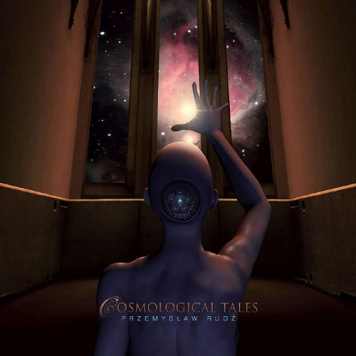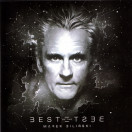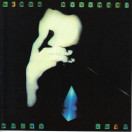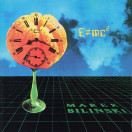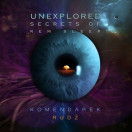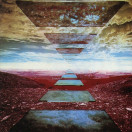Przemysław Rudź
Cosmological Tales
49,00 PLNabout 10,43 EURbrutto
| ARTIST | Przemysław Rudź |
| LABEL | Generator.pl |
| NUMBER | GEN CD 017 |
| RECORD DATE | 2010 |
| MEDIA | 1CD |
| PACKAGE | JEWELCASE |
| Kod produktu | 006134 |
| POPULARITY |
Lista utworów
| Through The Planck Era |
| The God Particle's Dance |
| Let There Be Light |
| Islands Of The Universe |
| We Live Here |
| Disputable Future (feat. Jarek Figura) |
Opis
It's with a full blast from a metallic synth Through the Planck Era opens.
These are shots across the bows that strike, making us jump, among which synth resonances and residues spread their tones over fine twinkling notes, paving the way to strong twisted solos of synth which roar in a powerful electronic atmosphere. After this deafening intro, Through the Planck Era floats between two zones of rhythms with multidirectional chords sequences which mold a serrated pace. An ambivalent rhythm with slow synth sparkle which wave under fine twinkling of glass, trapped of heavy pads of a foggy mellotron. Inside its8 minutes, Through the Planck Era reveals the musical duality that reigns towards the 6 tracks of Cosmological Tales. If
Przemyslaw Rudz
had seduced and gained the charm of new fans withSumma Technologiae
, this 2nd opus risks to disappoint them because the musical approach of the Polish synthesist is different and transcends the zones of comfort of music to thousand possibilities.The God Particle's Dance is the kind of musical piece which hangs instinctively the hearing. A beautiful track which has all the elements to please and which begins with a mellotron waltz of which foggy pads float lasciviously with a set back soft synth whistling its melancholic air. A soft oniric intro disrupted by a sequential line with chords that skip and hiccup with good percussion strikes which hammer a pace silkily wrapped in a mellotron mist. Synth solos fuse and get entangled around sequences coupled to limpid keyboard keys, creating a cozy bed of twinkling arpeggios caught in a mellotron mist. Let There Be Light presents the first atmospheric and atonal moments of Cosmological Tales with unusual synth tones which collide in a cosmos perfumed of dark hooting and whooshing pulsations which pulse among chain of fine crystal clear tones scrolling eclectic snigger. A curious psychedelic-electronic world which slowly takes a more musical shape when latent synth waves wrap this heterogeneous introduction to make it waltz in a cosmic oblivion from where appears a delicate sequential movement with doubled chords. Chords which waddle in a zigzag hunted by reverberations and synth serpentines, before acting alone in an ephemeral tranquility rushed by heavy synth strata with edgy orchestrations. Let There Be Light espouses then a rhythmic structure which skips such as street gangs' allures in an environment punctuated with sequences which tinkle among suave solos of synth.
Islands of the Universe is an intense cosmic ballet that will end as it begun. A long track, more atmospheric than atonic, which presents us another facet of
Przemyslaw Rudz
. The intro plunges us into a musical universe submerged by strange breezes and reverberations of a cosmic tribal world. Rumblings of galactic thunders and shooting streaks accompany this mixture of tribal elements, reflecting the universe of magmatic fusion of Jarre on Les Chants Magnétiques. This atmospheric intro makes room to a more melodious segment where strata of a hatched synth waltz such as pleasant snowflakes, reminding the fabulous structure of Snowflakes are Dancing. These synth strata dances with soft notes of a solitary piano before being melt in vast synth breath which recovers the middle of Islands of the Universe by a somber abyssal coat. A cold silvered sequence a'la Stuntman fromEdgar Froese
is coming out of it. She waves and pulses under a rain of cosmic streaks, embracing Frédéric Mercier's analog and oniric universe in Songs from France, while another short-lived sequence is joining to strum brief fast flows, before Islands of the Universe dives back into the tribal and morphic approach of its intro. Always in ambient and melodious mode, We Live Here presents us a magnificent ode to melancholic with a magnificent piano which spreads its solicitude a pouring rain and thunders being serve as its companion. Very beautiful and sensitive, it is the kind of music that melts the ice around the misled souls. Disputable Future encloses this 2nd album ofPrzemyslaw Rudz
with a more rock approach where nervous and feverish sequences are joined by unbridled percussions and where the synth with stormy undulations and twisted solos is supported by a heavy rock guitar. A heavy and powerful track which doubtless tries to rally fans a bit confused whom had discovered a more rhythmical and melodiousPrzemyslaw Rudz
on Summa Technologiae.Although very different from Summa Technologiae, I quite liked the musical adventure of Cosmological Tales. I discovered there a musician who, without denying his influences, goes out of his comfort zone to offer an album where rhythms still heavy are mixing quite well with atmospheres as poetic as oniric. Cosmological Tales is an album divided well between rhythms and atmospheres with all the power and the sweetness which livens up these two paradoxes which live pretty well on this
Przemyslaw Rudz
2nd effort.Sylvain Lupari gutsofdarkness.com & synth&sequences.com
With Cosmocological Tales, Polish synthesist
Przemysław Rudz
present us his second album, a recording graced with a fresh, melodic, vibrant and well-produced sound.The cd fires off with a fine combination of well-tempered sequencers and rhythms building a bridge with pads of warm digital and analogue sound, with some infectious solos served on top. The third track Let there be Light, clocking at 14 minutes, though sets off in an experimental vein, but fortunately the music starts to slowly shift to more harmonious output later on, although it doesnt get near the sweeping impact of the previous pieces. The 20-minute Islands of the Universe also has a long atmospheric intro-section before a hypnotizing, minimal sequencer patterns and effects keep spiralling up and down. After a break with a kind of cosmic blasts and sonic whirls the music seeks its way out with a mesmerizing sequencer motif.
On We Live Here. Mr
Rudz
takes the moody, reflective alley with piano, thunder and rain sounds, all making up a fine interlude in which a classic touch is present. The disc rounds out with the up-tempo Disputable Future, which sees one Jarek Figura join Przemysław on e-guitar. After an alienating opening, catchy polyphonic sequencing, drums and analogue synth pads come in, soon followed by energetic guitar solos.All in all, this album blends the contemporary sound with analogue vibes, but at the same time also turns things inside out and takes it in a different direction. Unfortunately, the second half of the cd also suffers from the expansive sections where the musician seems to be just dabbling around, forgetting he should be moving forward to keep it interesting.
Bert Strolenberg
Following down the path of only bringing you what we consider to be the finest of the new Synth Music CD releases from around the world, here is another that fits that category well.
Przemslaw Rudz
is a Polish synth musician heavily influenced by the uniform synth lead melodic and rhythmic styles ofJean Michel Jarre
andKlaus Schulze
, plus there are some hints atTangerine Dream
in there too, but it's all from the 70's/80's periods of these musician's career. TheRudz
sound is very powerful and forthright, using a lot of Mini-Moog sounds for this lead work. There are a lot of splashes of raw industrial synth power within this music with some of the Mini-Moog works, at times, being almost Wakeman-esque in construction. The opening track: Through The Planck Era is a perfect example of this, as the Moog melodies compete with heavy rhythms and the strong swishes and swooshes of the other synth textures - a strong opener for the album that makes you sit up and listen.God Particle's Dance has another fast-ish, infectious Jarre style melody-line with electronic rhythms & percussion set over a strong bed of string synths and other keyboard effects. Let There Be Light opens with the first abstract passage on the album in a setting of tinkling and warbling synth sound patterns and textures, until it starts to take off on a bank of emerging deep and sweeping space-synth textures, with the insect-like life-forms circling above. Later, a deep sequencer rhythm (very TD-like) emerges through the electronic mist and meanders around for a bit until a striking electro rhythm kicks in. Busts of occasional "big" synth orchestra sampled stabs that sound not unlike those used on the Yes track: Owner Of A Lonely Heart, punctuate the rhythmic forces, then a soaring synth melody-line soars in and guides us on a trip through a nebula of spacey sounds and a vibrant rhythmic flow that has the feel of
Schulze
in rhythmic overdrive, before eventually fading over the horizon with only a small synth ion trail left behind. Islands Of The Universe starts out in what sounds like the dark lands of the Australian outback, with deep, staggered synth textures creating that feeling of a vast and hostile open landscape, and as it develops, it eventually opens out into a mix of repetitive electronic rhythms and simple melodic motifs that form a Jarre-like section where swooping and swirling synth winds and spiralling effects coupled with sequencer patterns forms an extend passage that never really takes off as you expect it might, then fades back to more of the dark atmospheric landscapes of the opening sequence.Rainclouds gather and thunder rolls in for: We Live Here which is a piano piece that is ravaged by periodic loud claps of thunder and a constant downpour of rain, and although the description probably doesn't do it any favours, the track does work really well as it flows through a series of high and low moods.
The closing track: Disputable Future features the electric guitar sounds of Jarek Figura, and after a cavernous, alien-like opening passage, the sequencer and Jarre-like synth sounds enter and strike up a vibrant driving backbeat that, with added percussion, becomes a real flowing, rhythmic piece of "EM", but when the guitar takes up the lead over a sea of string and other synthesizers, the track really takes of and goes orbital, bringing the album to a dramatic and high-flying close. Overall, for a CD released in 2010 this album has an "analogue" feel and sounds like it was made for the mid-70's - mid 80's. It's quite inventive at times and although the major influences are there you get the feeling that
Rudz
is certainly putting his own take on the scene, mixing melody (great Moog solos) with vibrant rhythmic ideas and powerful atmospherics is equal quantities - Nice one!CD Services team
This is already a second
Przemyslaw Rudz's
release by Generator.pl - a 70 minute portion of pretty good sequential electronica and ambitious elpop synthesis. On this record, you may find moods corresponding to music made byUnder The Dome
,AirSculpture
andJean-Michel Jarre
orVangelis as well. The opener is a 8 minute long synthesis of funky glittering sounds a la Stuntman by Edgar Froese
and Manikin Records - or Neu Harmony-like groove fantasies. The first "true hit" is the second piece, the shortest one on the CD, in which Rudz
continues the tradition he explored on his earlier successful Generator-CD. What we are dealing here with is, first of all, a catchy melody and a rocky rhythm-pattern in the background; the whole sounds as if it were arranged and played by some early Marek Bilinski
, who is in the mood for The Other Side of the World - here they are, these wonderful "jarre'ing" sounds and thick clouds of melancholic chords, so sunny and yet so icy at the same time indeed. The third impression grows up on the field of abstract noises and washes, then there appears a dynamic, fluorescent ostinato-percussive line; you may dream away for some 14 minutes and then the piece is suddenly over. The main dish is beyond any doubt the track no. 4 with its 20+ minutes; Rudz
is playing with traditional sequential patterns a la Manuel Goettsching
, his furious polyphonic impression could fit very well in the most dynamic sections of the film Koyaanisqatsi. Track 5 is the most quiet and reflexive one in the whole set; you may enjoy some warm piano sounds intermingling with an environmental rain-soundtrack and occasionally recurring thunderstorm voices. Rudz
conjures up an atmospheric track a la Detlef Keller's
The Story of the Clouds, well, you may also think about Marek Bilinski's
Reflections for a while. The last composition is an optimistic, upbeat piece somewhat resembling Tangerine Dream's Melrose sessions; first of all, there is this very guitar-solo and a nice touch of polyphonic sequencing in the background. All in all, Cosmological Tales is a very interesting album, consisting of classic, modern and daring electronica. One should really pay attention to very professional multi-track arrangements. Have a nice cosmic trip... round and round, again and again...
Igor Wróblewski
Edgar Froese
and Manikin Records - or Neu Harmony-like groove fantasies. The first "true hit" is the second piece, the shortest one on the CD, in whichRudz
continues the tradition he explored on his earlier successful Generator-CD. What we are dealing here with is, first of all, a catchy melody and a rocky rhythm-pattern in the background; the whole sounds as if it were arranged and played by some earlyMarek Bilinski
, who is in the mood for The Other Side of the World - here they are, these wonderful "jarre'ing" sounds and thick clouds of melancholic chords, so sunny and yet so icy at the same time indeed. The third impression grows up on the field of abstract noises and washes, then there appears a dynamic, fluorescent ostinato-percussive line; you may dream away for some 14 minutes and then the piece is suddenly over. The main dish is beyond any doubt the track no. 4 with its 20+ minutes;Rudz
is playing with traditional sequential patterns a laManuel Goettsching
, his furious polyphonic impression could fit very well in the most dynamic sections of the film Koyaanisqatsi. Track 5 is the most quiet and reflexive one in the whole set; you may enjoy some warm piano sounds intermingling with an environmental rain-soundtrack and occasionally recurring thunderstorm voices.Rudz
conjures up an atmospheric track a laDetlef Keller's
The Story of the Clouds, well, you may also think aboutMarek Bilinski's
Reflections for a while. The last composition is an optimistic, upbeat piece somewhat resemblingTangerine Dream's Melrose sessions; first of all, there is this very guitar-solo and a nice touch of polyphonic sequencing in the background. All in all, Cosmological Tales is a very interesting album, consisting of classic, modern and daring electronica. One should really pay attention to very professional multi-track arrangements. Have a nice cosmic trip... round and round, again and again...
Igor Wróblewski
Inni klienci wybrali
Podobne albumy
Kup Przechowaj
Goods in stock
Wysyłamy do 1 dni
Dostawa w do punktu odbioru już od 12zł.
Przesyłkę dostarcza Poczta Polska lub Inpost.
Możliwy odbiór osobisty poza siedzibą sprzedawcy.


